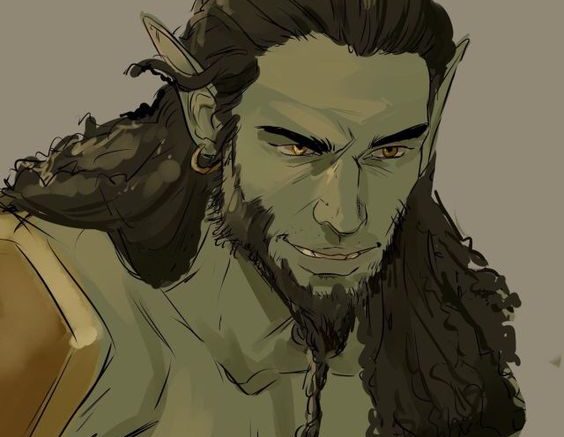In real life, we all sometimes feel bound by caution and frustrated by rules of decorum, so we enjoy characters who act recklessly, play by their own rules, and boast the power to ignore the consequences.
This accounts for some of the appeal of gangster films and of evil D&D characters.
The Advanced Dungeons & Dragons Player’s Handbook (1978) introduced half-orc characters. They stemmed from evil and seemed suited to it.
Those first edition rules limited a half-orc’s top level in every class but assassin, so only half-orc assassins saw much play. Author Gary Gygax surely figured that evil half-orcs would have a knack for assassination, but the combination lacked much appeal. Orcs bring strength and battle lust, not cunning and methodical planning. Assassins fueled conflict between players, and the role concerned some parents, so second edition dropped the class. (See Why Second-Edition Dungeons & Dragons Dropped Thieves and Assassins.)
At first, D&D pictured orcs with pig faces and described them as evil bullies willing to “breed with anything” and eager to capture human slaves. This led many people to conclude that half-orcs came from rape.
The half-orc’s history in the game suggests that the D&D team shied from featuring a playable race that implies a dark background of sexual violence. As designers wrestled with the half-orc’s backstory, the race came with the first and third editions of the Player’s Handbook, and left with the second and fourth editions of the book.
Many players enjoy mighty, reckless characters who thrive on melee. They relish the chance to ignore caution, rush into action, and destroy foes. No race supports the style half as well as the half-orc, so the option kept reentering the game. Especially when third edition’s Player’s Handbook combined the berserker archetype into the barbarian class, half-orcs gained popularity.
Most of D&D’s editions offer goliaths to players interested in big, mauling fighters, but almost everyone favors half-orcs. Goliaths, a sort of diluted half giant, come so low on flavor that few player’s can pick one from a lineup.
Through D&D’s editions, the designers worked to free half-orcs from their worst implications.
In second edition’s Planescape setting, the half-orc leader of the Bleaker faction comes from a loving marriage between a human and an orc. The pair came to Sigil seeking tolerance. The setting’s authors felt that a human-monster romance needed some explanation, so in the tradition of Alicia Masters, they made the human parent blind.
Half-orcs can be explained without the implication of rape. The race came from Tolkien and his half-orcs stemmed from interbreeding between orcs and unsavory humans allied with Sauron or Saruman. Third edition steered in a similar direction. “In the wild frontiers, tribes of human and orc barbarians live in uneasy balance, fighting in times of war, and trading in times of peace.” Trading, indeed. Face it, orcs don’t really need to be less evil or monstrous for some humans to willingly interbreed with them. Evidence supports the notion that humans can be outrageously indiscriminate about who or what they couple with.
Still, rather than explaining half-orcs as the product of human-orc interbreeding, fourth edition made them a completely separate race. As backstory, the Player’s Handbook 2 offers a menu of mythic explanations to choose from. For example, perhaps a part of the god Gruumsh’s savage essence fell to earth and transformed a tribe of humans into a new species. Like many ideas floated in fourth edition, half-orcs didn’t remain a species.
Fifth edition frees half-orcs from their darkest implications by developing the nature of orcs. Their evil and savagery stems from their devotion to Gruumsh and the rest of their gods. Orcs follow a faith that preaches blood and conquest, backed by actual gods able to give followers divine powers. No wonder orcs behave so badly.
Outside of Gruumsh’s influence, orcs can escape savagery. “Most orcs have been indoctrinated into a life of destruction and slaughter. But unlike creatures who by their very nature are evil, such as gnolls, it’s possible that an orc, if raised outside its culture, could develop a limited capacity for empathy, love, and compassion.” Perhaps the son of a human and a loving orc could even grow into a factol in Sigil.
Although fifth edition makes half-orcs the product of interbreeding, the game makes the mix common enough for form self-sustaining communities. “In lands far from the Sword Coast, such as Thesk and Chessenta, there are large communities of half-orcs, where generations of them have lived as a people in their own right.”
The story behind D&D improves by making orcish savagery a product of violent gods. In the early days of D&D, orcs only differed from other humanoids by resembling pigs rather than hyenas or big goblins. Now, orcs stand out for their spiritual devotion, and this backstory makes orcs more layered and interesting. Allowing orcs a capacity for love and compassion helps solve the question of what could lead a human to pair with an orc. Plus, the story answers whether good adventurers can murder baby orcs with a clear conscious. I always hated the baby orc dilemma.
Article plucked from:
https://dmdavid.com/tag/how-dd-shed-the-troubling-implications-of-half-orcs/

Be the first to comment on "How D&D Shed the Troubling Implications of Half -Orcs"